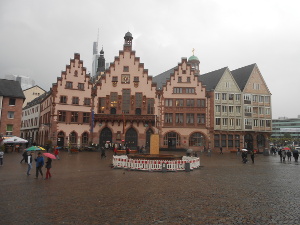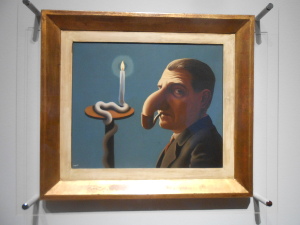On this trip to Frankfurt we selected the Monopole Hotel, an older building directly across the street  Modern Frankfurt on the Main
from the Hauptbahnhof. It turned out to be a comfortable place - a representative example of German hotels, with a Japanese twist (miso soup and other Japanese food because of a clientele of visiting Japanese businessmen). We expected to be riding the trains, so the location was important, although the Frankfurt tourist guides tend to downgrade the area close to the station because of its high mix of non-German ethnicities.
Modern Frankfurt on the Main
from the Hauptbahnhof. It turned out to be a comfortable place - a representative example of German hotels, with a Japanese twist (miso soup and other Japanese food because of a clientele of visiting Japanese businessmen). We expected to be riding the trains, so the location was important, although the Frankfurt tourist guides tend to downgrade the area close to the station because of its high mix of non-German ethnicities.
Speaking of ethnicities, the guide on the hop-on, hop-off tourist bus said 65% of people living in Frankfurt were not from Frankfurt. We took this bus on our first day to recover from jet lag and enjoyed  Monumental euro
making several stops and listening to the excellent English commentary on channel 2 on our headsets. We also discovered parts of the city we hadn't visited before.
Monumental euro
making several stops and listening to the excellent English commentary on channel 2 on our headsets. We also discovered parts of the city we hadn't visited before.
Frankfurt is, first of all, a finance center - in fact, the principal finance center for the European Union, as it is the headquarters of the European Central Bank and the birthplace of the euros which we had in our wallets. There are over 300 banks in Frankfurt, and a correspondingly large number of bankers, who are anticipating taking away a lot of euro-based banking from the City of London after Brexit.
Frankfurt is also known for trade fairs - the annual Book Fair is probably the biggest in the world, appropriately as the market for Gutenberg's first publication of the Bible (it was actually printed in nearby Mainz).
 Alte stadt in the rain
Alte stadt in the rain
But Frankfurt has an alte stadt (old city) with a restored rathaus (city hall) and dom (cathedral). We got off the bus there and had lunch at a restaurant we'd visited on a previous trip, just across the square from the rathaus, which is a popular venue for economical weddings. We remembered the white asparagus grown in the dark which is so popular in Germany, called spargel, and tried it for lunch. It was good, but not as great as the sweet wild asparagus that grew on our land in Inyokern, California. But the rump steak and country ham that accompanied the spargel were excellent traditional German favorites, as was the apple pastry with ice cream for desert. In the weeks to come we kept seeing spargel for sale in markets  La lampe philosophique
and vegetable stands.
La lampe philosophique
and vegetable stands.
We were going to visit the cathedral after lunch, but signs for a Magritte exhibit caught our eye so we headed for the Kunsthall. This astonishing show included many Magritte paintings we had never seen, many of which are held in private collections. We took a lot of photographs which we'd be glad to share with aficionados.
We finished our hop-on tour in a heavy rainstorm, so we did not hop off again, but listened to the guide tell us about Goethe, who was born here but grew up in nearby Weimar, the many museums which we planned to check out the next day, and the narrowness of German skyscrapers, due to a law requiring offices  Street market
to have an outside window. There's no bedrock in Frankfurt, just a lot of soft mud, so the buildings sit on top of bases of reinforced concrete, up to 50 meters deep.
Street market
to have an outside window. There's no bedrock in Frankfurt, just a lot of soft mud, so the buildings sit on top of bases of reinforced concrete, up to 50 meters deep.
The following day we were ready to start walking, starting along the riverside, where Frankfurt has grouped many museums, of art, history, culture and technology, on a beautiful tree-shaded street. Families were out walking, visiting the museums as well as a large street market stretching for many blucks and including just about everything, from ice skates to clothing to musical instruments.
We entered the Giersch Museum, which had an exhibit of abstract art by German artists starting in the  Primitive weaving loom
1950s, and then visited the Museum of World Cultures whose current exhibit is about textiles. There were primitive looking textile tools from faraway countries like Bolivia and Guinea along with samples of their products and videos depicting the tools in use. We saw films of things like twisting fiber from coconuts or palm leaves into cord, then plaiting the cord, making and using dyes and decorative patterns.
Primitive weaving loom
1950s, and then visited the Museum of World Cultures whose current exhibit is about textiles. There were primitive looking textile tools from faraway countries like Bolivia and Guinea along with samples of their products and videos depicting the tools in use. We saw films of things like twisting fiber from coconuts or palm leaves into cord, then plaiting the cord, making and using dyes and decorative patterns.
This museum takes one topic at a time, and prepares exhibits which illustrate it across the world, leaving plenty of time for students to visit and study them. It is not one of the flashier museums, like the art museum or the transportation museum which are well known to visitors, but it has found a pleasant location and offers a new look at familiar objects.
After lots of good exercise, we decided to take a train trip somewhere the next day.
 Modern Frankfurt on the Main
from the Hauptbahnhof. It turned out to be a comfortable place - a representative example of German hotels, with a Japanese twist (miso soup and other Japanese food because of a clientele of visiting Japanese businessmen). We expected to be riding the trains, so the location was important, although the Frankfurt tourist guides tend to downgrade the area close to the station because of its high mix of non-German ethnicities.
Modern Frankfurt on the Main
from the Hauptbahnhof. It turned out to be a comfortable place - a representative example of German hotels, with a Japanese twist (miso soup and other Japanese food because of a clientele of visiting Japanese businessmen). We expected to be riding the trains, so the location was important, although the Frankfurt tourist guides tend to downgrade the area close to the station because of its high mix of non-German ethnicities.
 Monumental euro
Monumental euro Alte stadt in the rain
Alte stadt in the rain La lampe philosophique
La lampe philosophique Street market
Street market Primitive weaving loom
Primitive weaving loom